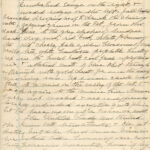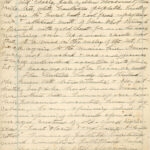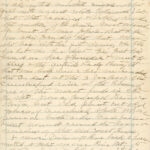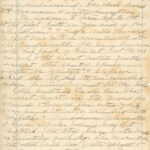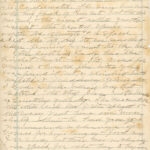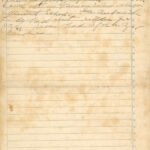Pine Mountain Settlement School
Series 09: BIOGRAPHY – Staff
Series 07: DIRECTORS
Katherine Pettit 0000
Larnin’ on Greasy (n.d.)
KATHERINE PETTIT WRITING Larnin’ on Greasy (n.d.)
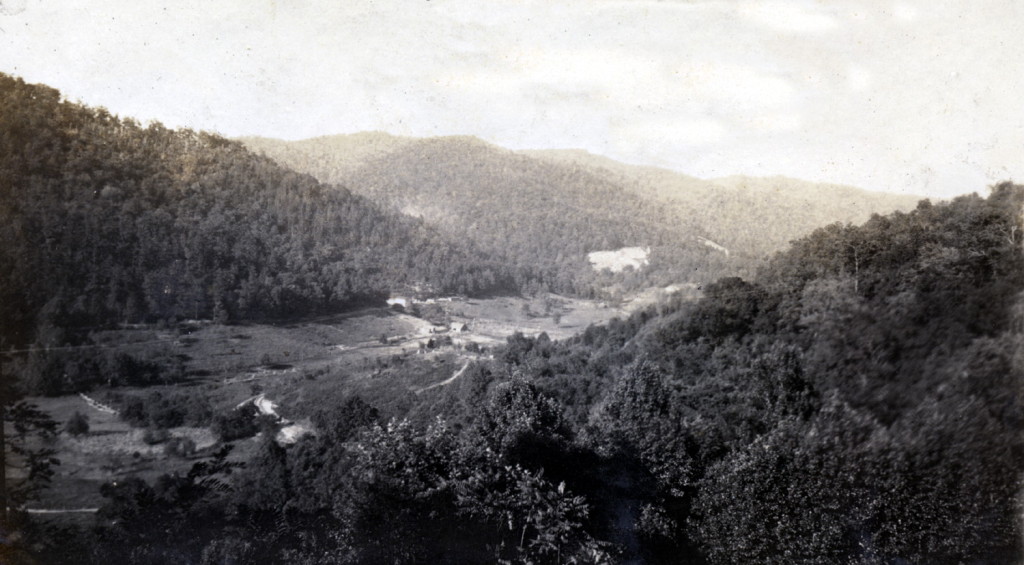
“Pine Mountain Settlement School. 1923-4-5 – The First Glimpse” of Pine Mountain Settlement School coming from the west across Laden Trail. [nesb_071_mod.jpg]
TAGS: Katherine Pettit, travels in Appalachia, Greasy Creek, Kentucky River, childhood education, rural Appalachia, early 20th century travel, horseback riding, Cumberland River, transcription
Notes on: KATHERINE PETTIT Larnin’ on Greasy (n.d.)
“Larnin’ on Greasy” is essentially a travel journal. Handwritten in the large hasty scrawl so typical of Katherine Pettit, the brief record describes a saga of mountain travel that seems to be certainly the work of Katherine Pettit, Founder and Director of Pine Mountain Settlement School in Harlan County, Kentucky. The large and loose scrawl of the author is unmistakable and vivid in its description of the surroundings. The saga described by the writer captures the journey with the eye of a seasoned traveler — which Katherine Pettit certainly was. Yet, this particular journey with the “Outside Lady” seems particularly rugged. Riding a horse over the mountains of Eastern Kentucky was a far cry from the rolling Blue Grass or even the mountain valleys. It was a journey that Pettit and so many other early travelers had to make to reach the early remote Settlement School on the north side of the steep Pine Mountain range. It would not be the last time she would make that journey.
The four-page handwritten account captures the journey as a tale of two travelers who arrive by train in Harlan County and then journey across Pine Mountain and end at what must be Big Laurel at the head of Greasy Creek. The two women, one the narrator and the other referred to as the “Outside Lady,” are described as unaccustomed to the life and customs of the region and are on a great adventure. The undated short tale suggests that the journey may have been sometime during the first years of planning for building the new settlement.
The narrator describes the journey as one might journey in a foreign land. This journey would have occurred after Katherine Pettit’s some nine years at Hindman Settlement in neighboring Leslie County. And, this seeming lack of familiarity with place, gives the tale an even stronger sense of mystery. If, in fact, Pettit is, the author of the tale, she is borrowing a writing style that was common by the beginning of the twentieth century.
The narrator, Pettit, is clearly working within familiar geography and familiar literary history. She would then have had much more experience than the narrator of this short tale, and this, her tension of truth and fiction makes the brief account a lively read. Further, Pettit had many journeys by horseback as she explored the area looking for woven coverlets and “kivers” with the same population she describes. This interesting dis-join of her experience and the in-experience of her traveling companion may not have been what she aimed for … but it is what makes this little narrative so very intriguing. Is it a journal, a writing exercise mimicking the style of the day, or an attempt to disguise her identity? Is it fact or fiction?
It is curious that Katherine Pettit would elect to write in a popular form as though she was on a journey of first discovery. Though clearly a well-seasoned mountain traveler, though largely on foot, she writes as though she is unaccustomed to some of the conditions she experienced and appears to seek a literary connection with earlier so-called “Local Color” authors. Authors such as Sarah Orne Jewett (1849-1909), Rebecca Harding Davis (1831–1910), Mary Noailles Murfree (1850-1922), (who preferred to be known as Charles Eggbert Craddock), all roamed the Appalachians in search of adventure and literary fame in the early years of the twentieth century. These “Local Color” writers were fascinated by the “local color” of nature as well as the colorful people and were intent on sharing their adventures with “outsiders.” The “Outside Lady” becomes Pettit’s sharing vehicle.
In this brief narrative, which includes the “insider” (Pettit,) and the “outsider,” (the “Outside Lady”), the writer is placed closer to the region and people, but remains an observer. Pettit was the insider woman in many ways, but interestingly, for most of her life, she was the outsider — the observer. She was seemingly immersed in the local culture and intent on translating the difficult journey and the living conditions while promoting her initiatives for the benefit of readers outside the region. She was persuasive. But, her motivations were clearly not the same as the Local Color writers. Or, were they?
This difficult to read and interpretive narrative scrap of what appears to be the work of Katherine Pettit does much to shed light on a general fascination with the culture, nature, and the social needs of rural Central Kentucky, and Appalachia, generally. It is a window into the lives of women and adventure in the first decade of the twentieth century. The brief four pages is also a window into the interior of Katherine Pettit; her ambitions, fears, and the compass she followed to build her dreams in a remote corner of her native State. Her need to break new ground and to claim new territory knew no bounds. Hers is a view of the world that was always a little peculiar but greatly admired by both women and men for her sense of adventure, fearlessness, and love of nature. Yet, in many ways, she was both fearful and fearless, kind but closed, insider and outsider, all in one body.
Charting Katherine’s many “sides” and her many journeys and adventures provide a reference point for those willing to step outside the boundaries of the common and find growth and reward in the uncommon adventure. This early narrative appears to be one of the earliest and most revealing of Pettit’s personal statements. For those attempting to understand this very complex Founder and Director of the Settlement School at Pine Mountain, this short narrative is remarkably instructive.
Reading the original document and not the transcript is even more instructive. Did we read it correctly? What did you larn?
See: Marthe Jocelyn Scribbling Women: True Tales from Astonishing Lives, 2011.
Transcription: KATHERINE PETTIT 0000 Larnin’ on Greasy (n.d.)
larnin_on_greasy_001a
larnin_on_greasy_001b
LARNIN’ ON GREASY
Up the winding Cumberland river the train went slowly with the densely wooded Cumberland Range (?) on the right, & wooded ridges on the left; full-leafed branches drooping as if to drink the shining water, …ing greens on the Mt. [mountain], from the dark of pine, to the grey splashes of linden leaves, dogwood, red bud, white plumes of the wild cherry, pale yellow blossoms of umbrella tree, white hawthorn, prophetic hints of red in the laurel buds cool, fresh, uplifting c… & ethereal mists of blue shot through & through with gold dust from the early morning sun. Up some creek and then to a mine in the valley of the Mt. & back again to the main line. Human hurry not marked & all indifference to any individual exception quite(?) plain. Let the hurrying one [person] get a horse or mule.
The Outside Lady was thrilled. She knew Mtns. transatlantic and cis-(?) at painting but she had never been in her Southern hills, house of our couor ….[common ?] but previous [?] ancestors, home of log cabin, loom, spinning wheel & home spun; of ancient speech, usages, customs of old-world superstitions, “haint” “sharitas??” long ballets [ballads] and “devils(?) ditties”, — houses of sympathetic hospitality amid conditions pathetically hard.
Amid the still flourishing moonshine & shinning (striving?) for better(?)….. croc(?)… of the fast disappearing frontiersman(?)
She noted the couple across
larnin_on_greasy_002a
larnin_on_greasy_002b
the aisle turn & study us two “furriners” frankly for a long while with the naive curiosity of children. Behind us she noted another couple — the girl with a great white beflowered(?) flat hat that swayed & wobbled under the motion of the train — most absurdly, but it was plain that she was very proud of that hat. When the boy with her got drowsy(?), she took his hat in her lap & he put his head on her shoulder & went to sleep and the Outside Lady thought that this was lovely.
In 2 hours we reached the crescent(?) at the 3 forks of the Cumberland river — the home of one of the worst feuds in the Ky. Mts. Now a peaceful mountain town, but I cd. [could] point out old places of ambush spots where men on both sides had fallen & [the] bullet wounds(?) around the doors and windows of the Old Court House.
8 more miles up Poor Fork 2 horses waited to take us over Pine Mt. to the new Settlement School on St. Helda (?) on Greasy. At the station appeared a merry middle-aged man with a smooth-face, a firm chin, a silhouette ? whose strength had been
larnin_on_greasy_003a
larnin_on_greasy_003b
hewn(?) “I’m going over to preach on Greasy Creek. My name is Newell (?). What is your name?” His tone was such that the Outside Lady was not even embarrassed. She shook hands, told her name, & introduced us.
We were to then to report (?) at the first prette [pretty house?] on “yon side of the Church (?) house” & half a mile onward a Mt.neer with ….(?) confirmation. The sun was warm on the long flank of Pine Mt. but the air was cool & the ascent rather gentle, except the crests of spurs — & often the trough of a spur, then up, only to see another ridge forming against the skyline.
The Outside Lady has the kindest heart in the world for animals & her old flea-bitten nag soon found it out, & clinched(?) with majestic & maddening dedication(?). I rode a full-bellied nag that tackled the steep places with ….(?) exhausting gallantry. The descent on the other side was quite resplendent [??] & the grey went down even more slowly than he had gone up. ??? ……(?) a change of horses for I was hungry & food was far away but there was no change in speed, for the bay to began to shirk so that going down one or the other was nibbling leaves, drinking from every pool, and stopping to rest whenever I ……(?) wherever ……..(?) he pleased …….(?)
larnin_on_greasy_004
Linemen only we met on the nag. “Follow the path” they said, then when we came out on Greasy below the Settlement School the Outside Lady who had not ridden for ages (10 yrs?), nor had I for a year or (?) more (?). [end]
GALLERY: KATHERINE PETTIT 0000 Larnin’ on Greasy (n.d.)
(Includes duplicates)
- larnin_on_greasy_001a
- larnin_on_greasy_001b
- larnin_on_greasy_002a
- larnin_on_greasy_003a
- larnin_on_greasy_003b
- larnin_on_greasy_004
SEE
KATHERINE PETTIT WRITING Guide

